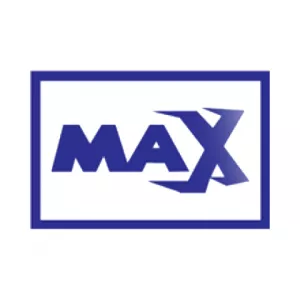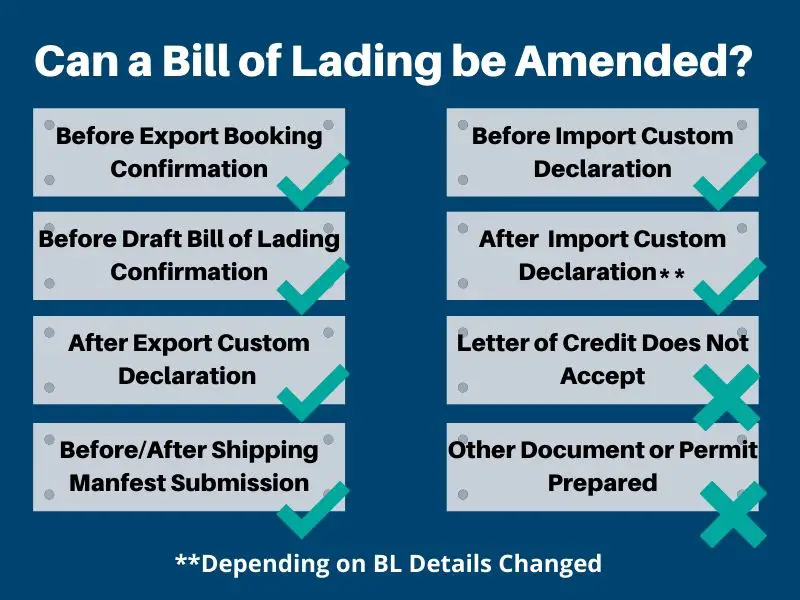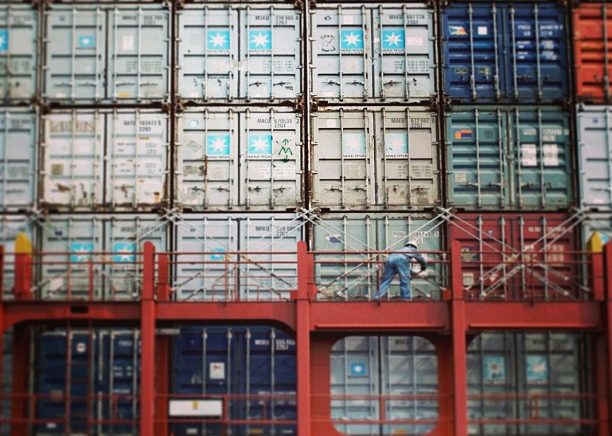


Once a booking confirmation for export has been set, shipping agents, forwarders and NVOCCs will prepare the bill of lading according to the details of the booking confirmation. But throughout the logistics processes, we must expect changes in shipment details or cargo details. So, can a Bill of Lading be amended accordingly? Yes, but nothing is set in stone. A Bill of Lading can be amended before or after the booking confirmation is made with the logistics service provider. The key area that stops agents from amending the bill of lading is when the shipping manifest as been prepared, or a letter of credit clearly states that the bill of lading has to be “clean”. In those circumstances, amending the bill of lading is more difficult, but still achievable. Let’s explore further in what circumstances it is easy to amend the bill of lading, and in what situation that amending bill of lading can be difficult. We also will explore the alternatives to the Bill of Lading amendments, how it affects the custom declaration process, and penalties involving the Bill of Lading amendments.


From an Exporter’s point of view, whether or not we can amend the Bill of Lading depends on whether the shipping agent has submitted manifest to the shipping agent at the port of discharge for processing. A shipping manifest is a document detailing all cargos carried onboard the vessel for customs, port operators and government permit issuing agencies to refer. They are prepared based on the bill of lading details compiled. After the booking confirmations have been complete, it is common practice for the shipping agents to prepare a draft bill of lading for the shipper/exporter’s final confirmation. This is an important process, particularly when the trade is financed by a bank via a letter of credit. If the exporter has not expressly confirmed the draft bill of lading, the shipping agents will not submit it for manifest preparation, the exporter can amend the bill of lading as often as they wish to, prior to the vessel’s departure cut off date of course. However, once the bill of lading has been confirmed, and shipping agents have submitted the manifest. Still, the shipper/exporter can request to amend the bill of lading. But this time, the shipper/exporter has to get the expressed approval of the shipping agent, as the shipping agents can choose not to amend the bill of lading accordingly. From an importer’s point of view, apart from a few caveats which we will discuss below, there is no obvious reason for the importer to amend the bill of lading. Furthermore, once the shipping manifest has been submitted to port operators and customs officers, amending the bill of lading will mean that the manifest and bill of lading details will differ. Consequentially, this may violate customs regulations and depend on the country, there will be a customs penalty for this misrepresentation.
Of the 6 Countries above, The United States, China, Japan and Europe rank as the largest economies of the world by GDP. Hence, the majority of the cargo shipment will have either a loading point or destination point in those countries.
Therefore, we have to be very mindful if we were to export products to those listed countries, as amending the bill of lading once the manifest has been submitted and approved requires more steps.

Apart from the countries that require advanced manifest submission (AMS), shipping agents in other countries have more time in shipping manifest submission. It is also not uncommon that shipping manifests are submitted after the vessel arrived and berthed at the Port of Discharge.
At this point in time, amending the bill of lading is still possible, either the importer or exporter can request for the bill of lading amendment via a formal letter or any methods the shipping agent requires.
Subsequently, the shipping agent will proceed with the amendment accordingly. Certainly, at the late stage, there will be a manifest correction fee.
Manifest Correction fee is incurred where the details of the bill of lading and shipping manifest differ, amending the bill of lading requires amending the shipping manifest.
The cost of manifest correction usually hovers around 40 USD, some shipping agents may charge higher than that.
In short, the bill of lading details will portray into the shipping manifest, and amending the manifest is possible, whether it is an AMS submission or standard manifest submission. of course, there will be a nominal correction fee stipulated.

So far, we have reviewed situations where amending the bill of lading comes with little or no consequence apart from an amendment fee. However, there are instances in which amending the bill of lading is more complicated and we will address it here.
We undergo Customs Declaration or Clearance after the following has been marked done: –
The Customs officer’s duty is heavily reliant on the documents submitted and the accuracy and consistency of those documents. Therefore, if there is any discrepancy between any of those documents, the customs officer may deem that there is intent to misrepresent and violate customs regulation.
Once the Bill of lading show any omission, error or mistakes when compared to other documents such as permits, manifests, or invoice. It comes to the customs officers to inquire, inspect or do anything necessary to assess the shipment.
If the details between bill of lading and other documents differ drastically, the importer cannot amend the bill of lading for customs clearance purpose. This is where the shipment is marked for inspection and inquiry, and depending on the importing country. There will be monetary penalties involved.
If the shipment involves a Letter of Credit, whereby the bank bears the risk of financing the trade and paying the exporter. If there are discrepancies between the instructions of the Letter of Credit and the Bill of Lading, amending the Bill of Lading is impossible.
In situations where the details of the bill of lading differ, such as the cargo weight, the container number, shipper/consignee spelling errors, we can escape with a claused bill of lading amendment.
Further details of what a claused bill of lading is are detailed in this blog post here. Basically, a claused bill of lading is where amendments of the bill of lading are written onto the bill of lading itself.
This is all fine when a letter of credit is not involved.
But if a letter of credit is involved, and the letter of credit stipulates that the bill of lading has to be ‘clean’ as opposed to a ‘claused’ or ‘dirty’ bill of lading. The bank will not issue the payment and release the documents to the intended importer.
The key takeaway from this blog post is that a bill of lading can be amended, but be very mindful when there are important supporting documents involved, such as the letter of credit and the certificate of origin.
These documents rely on the bill of lading details while amending the bill of lading is easy, we will have a harder time to amend other supporting documents that are either prepared by the bank or the government.
If a shipment is arranged with an Original Bill of Lading, traditionally there will be 3 original copies issued by the Shipping Agent.
When you submit an amendment request to the shipping agent, subsequently all 3 of the Originals have to be returned to the shipping agent, in order for the agents to issue a new original Bill of Lading. This step is not required if the Bill of Lading is either a Seaway Bill or a Telex Release Bill of Lading.
Hello! I'm Kelvin, I work as a custom broker and I'm thrilled with having the experience to share my industry knowledge with you. I hope that you enjoy reading them as much as I do posting them.